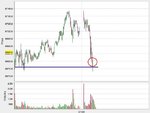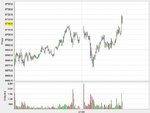new_trader
Legendary member
- Messages
- 6,770
- Likes
- 1,656
Yes - the body and wick represent prices at specific points in time during the time interval the candle covers. The same applies with the structure of a bar.
As I specified on another thread I would recommend, as an exercise, that price is followed in real time (at least from time to time). During the interval of creation of a candle/bar the observer will experience how/if it gradually/suddenly elongates from the opening price. The observer will also observe the acceleration and deceleration of the elongation or the moving of the current price between the high/low or see it create a new high/low.
Furthermore if this is accompanied by observing the level 2 screen the movement and volume of orders can be compared to the candle/bar formation in real-time and the price at which trades take place. Again an examination of the acceleration/deceleration/resting activity times can be very illuminating
In this fashion the "story" contained within the static completed candle/bar can be better interpreted.
Charlton
I understand. So in conjunction with what Socrates has been saying, would I be right in concluding that Candlesticks are nothing but an adjunct?



